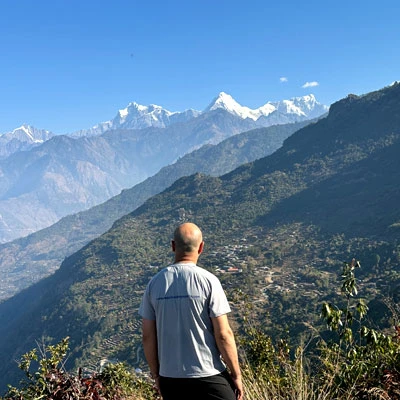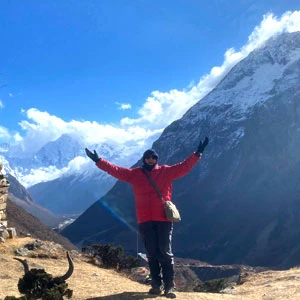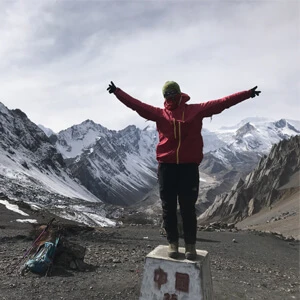Gokyo Lake Trek Overview
The Gokyo Lakes sit high in Nepal’s Everest region, within Solukhumbu District and Sagarmatha National Park. This collection of glacial lakes lies west of the traditional Everest Base Camp trail.
Here, the lakes are closely tied to major landmarks in the region. Gokyo Village rests on the shore of the third lake, Dudh Pokhari, beneath Gokyo Ri. It is a peak known for the best panoramic views of Everest, Lhotse, Makalu, and Cho Oyu.
Moreover, the Cho Oyu itself rises just north of the lakes, which is the major source for these glaciers. Similarly, the Gokyo Lakes also line the eastern edge of the Ngozumpa Glacier, Nepal’s largest glacier.
Its Formation And Geology
The Gokyo Lakes are fed by the nearby glaciers, particularly the Ngozumpa Glacier, the longest glacier in Nepal. Over the years, with fluctuating temperatures, meltwater from the glaciers filled these basins, forming the chain of lakes we see today.
Likewise, geological forces have played a crucial role in shaping the landscape around the Gokyo Lakes. Layers of rock debris, called moraines, left behind by the retreating glacier act like natural dams, holding the lakes in place.
Beneath the lakes, the mixture of compacted ice, rock, and sediment creates a constantly shifting foundation. Hence, with seasonal freezing and thawing, combined with glacial pressure, the views are ever-changing.
However, the same geological processes that created the Gokyo Lakes also pose potential risks. One major threat is glacial lake outburst floods (GLOFs). In such a case, the moraine dams can weaken and suddenly collapse under pressure.
Highlights That Make The Gokyo Lakes Special
- Every year, hundreds of pilgrims visit the lakes, especially during the Janai Purnima festival, to bathe in their holy waters.
- The lakes and surrounding valley host rare alpine flora and fauna, including endangered species.
- The crystal-clear waters of the Gokyo Lakes mirror the majestic peaks of Everest, Lhotse, Makalu, and Cho Oyu.
- As a part of the Sagarmatha National Park, the Gokyo lakes are UNESCO-recognized.
- The lakes serve as a starting point for challenging adventures like the Cho La Pass crossing and the Three Passes Trek.
How Many Gokyo Lakes Are There?
There are six main Gokyo Lakes officially recognized in Nepal's high Himalayas, each fed by glacial melt from the Ngozumpa Glacier. While these six dominate the landscape, the broader system includes several smaller ponds and water bodies scattered across the valley.
The First Lake: Longponga Tsho
Longponga Tsho, the first of the Gokyo Lakes, marks the beginning of the magical high-altitude lake system. It sits at an altitude of around 4,690 meters and is the smallest among the six main lakes.
If you are trekking to the upper Gokyo Valley, you will encounter its shimmering waters first. In Winter, the lake typically freezes over.
The Second Lake: Taujung Tsho
Taujung Tsho is the second lake in the Gokyo chain that lies just beyond Longponga Tsho at a slightly higher elevation (4,710 meters). Slightly larger than Longponga, this lake rests quietly among rugged, rocky moraines left behind by the retreating Ngozumpa Glacier.
As you get near Taujung Tsho, you will be greeted by its dark blue waters, contrasting beautifully with the grey and brown hues of the surrounding landscape. It is a peaceful and less-traveled viewpoint compared to others.
The Third Lake: Dudh Pokhari
Dudh Pokhari is the third and most renowned of the Gokyo Lakes that sits at the heart of the valley at an elevation of around 4,750 meters. Its name means "milk lake" in Nepali. It got its name due to the lake’s striking milky-blue color, which is a result of fine glacial silt suspended in the water.
On its eastern shore, you will find the peaceful village of Gokyo with towering Himalayan peaks rising in every direction. Dudh Pokhari also serves as the starting point for the popular Gokyo Ri hike, where you will get breathtaking sunrise and sunset views over Everest, Lhotse, Makalu, and Cho Oyu.
The Fourth Lake: Thonak Tsho
Thonak Tsho is the fourth lake in the Gokyo system that stretches out as the largest and one of the most pristine lakes in the valley. It sits at an altitude of 4,840 meters, tucked away further from the main trekking route.
This glacial lake rests in a quiet, untouched part of the landscape, making it a hidden treasure. If you happen to visit this lake, you will find its vast expanse of deep, clear water mirroring the sky and the surrounding peaks with stunning clarity.
A fun fact: only a few trekkers take the effort to reach Thonak Tsho because of its distance and higher altitude. However, if you want to experience a sense of true wilderness and isolation, you must not forget to visit it.
The Fifth Lake: Ngozumpa Tsho
Ngozumpa Tsho (at 4,980 meters) is the fifth lake in the Gokyo system that lies close to the imposing Ngozumpa Glacier, the largest glacier in Nepal and one of the longest in the Himalayas. This lake embodies the raw power and beauty of the high-altitude terrain, with its icy blue waters framed by the jagged walls of glacial debris and snow-capped peaks.
From its shoreline, you can take in dramatic panoramic views of Everest, Nuptse, and Makalu. Nearby this lake, you will also find Scoundrel’s Viewpoint. This lake is also one of the least visited among the others.
The Sixth Lake: Gyazumba Tsho
Gyazumba Tsho is the sixth and highest lake in the Gokyo system. This lake lies deep in the upper reaches of the valley. Perched at an elevation nearing 5,000 meters, this remote glacial lake remains largely untouched.
This lake has a wild feel as it is surrounded by rugged landscape. If you reach Gyazumba Tsho passing the conventional routes, you will get to explore raw Himalayan wilderness with only the sound of the wind and distant icefall for company.
Trekking To The Gokyo Lakes: What You Need To Know
Trekking to the Gokyo Lakes offers one of the most rewarding adventures in the Everest region, with several popular routes to choose from. You can follow the classic Gokyo Valley Trek, starting from the main Everest Base Camp trail, which leads directly to the stunning lakes.
Besides, you can also combine Gokyo with the thrilling Cho La Pass crossing to create a dramatic loop that connects with the Everest Base Camp Trek. If you are seeking the ultimate challenge, you should try the Everest Three Passes Trek, including Gokyo Lakes as one of its major highlights.
Moving on, to enter the region, you must secure two key permits: the Khumbu Pasang Lhamu Rural Municipality Entrance Permit, issued at Lukla or Monjo, and the Sagarmatha National Park Entry Permit.
Conservation Efforts For The Gokyo Lakes
The Gokyo Lakes enjoy special protection as part of Sagarmatha National Park, a UNESCO World Heritage Site that safeguards one of the world’s most fragile high-altitude ecosystems. Despite this protected status, the growing tourism has put pressure on waste management systems and local resources.
Hence, the park authorities have been working alongside village councils to promote sustainable tourism practices, enforce waste disposal regulations, and educate trekkers on responsible travel.
Best Time To Visit The Gokyo Lakes
The best time to visit the Gokyo Lakes is during the stable trekking seasons of Spring (March to May) and Autumn (September to November).
In Spring, the trails come alive with blooming rhododendrons, and the weather offers clear mornings and warmer daytime temperatures. Likewise, Autumn brings crisp skies, minimal rainfall, and breathtaking mountain views with uninterrupted panoramas of Everest, Cho Oyu, and the surrounding peaks.
Now, while Winter (December to February) brings harsher cold and heavy snowfall, if you are ready to brave the season, you will find absolute solitude, frozen lakes shimmering like glass, and surreal, snow-blanketed scenery.
Moving on, the Monsoon season (June to August), however, is generally best avoided due to heavy rains, leech-infested trails, and limited visibility.
Conclusion
The Gokyo Lakes stand as a breathtaking testament to the raw beauty, spiritual depth, and adventurous spirit that define Nepal’s high Himalayas. These shimmering turquoise lakes, set against the backdrop of towering giants like Everest and Cho Oyu, offer stunning views, deep religious significance, and provide a rare window into one of the world’s most unique ecosystems.
As you dream of visiting this hidden jewel of the Everest region, it’s vital to travel responsibly and help protect its fragile beauty for future generations. When you are ready to embark on this unforgettable journey, trust Nepal Trekking Experts to guide you with expertise, care, and a deep respect for the land.
FAQs
What is the Gokyo Lakes trek?
The Gokyo Lakes trek takes you through the stunning Gokyo Valley to visit the six high-altitude glacier lakes, offering breathtaking views of the Everest region.
How many lakes are there in Gokyo?
There are six main lakes in the Gokyo system, with the first lake, Longponga Tsho, being the smallest, and the sixth, Gyazumba Tsho, the highest.
What is the best time to visit the Gokyo Lakes?
The best time to visit is during the Spring (March to May) and Autumn (September to November) for clear weather and stunning views.
Do I need any permits for the Gokyo Lakes trek?
Yes, you will need the Khumbu Pasang Lhamu Rural Municipality Entrance Permit and the Sagarmatha National Park Permit for trekking in the region.
Is the Gokyo Lakes trek suitable for beginners?
While it is challenging due to high altitudes, the trek is doable for fit beginners, especially with proper preparation and acclimatization.
What makes Gokyo Lakes special?
Gokyo Lakes are unique due to their stunning high-altitude beauty, spiritual significance, and pristine glacial environment.
How difficult is the Gokyo Lakes trek?
The trek is moderate to challenging due to the altitude, but it’s accessible for trekkers with a reasonable fitness level.
Can I combine the Gokyo Lakes trek with other Everest region treks?
Yes, you can combine Gokyo Lakes with the Everest Base Camp trek or the Everest Three Passes trek for a more comprehensive adventure.







